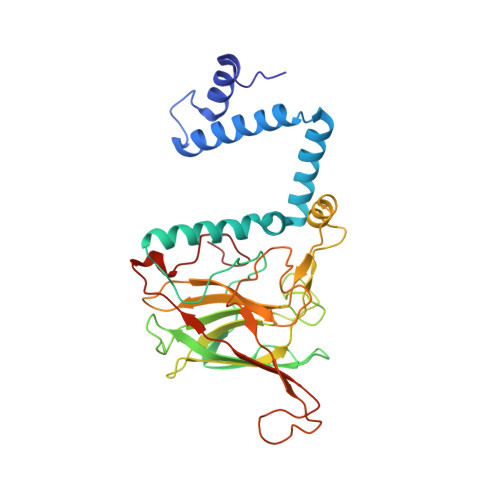Structure of catechol 1,2-dioxygenase from Pseudomonas arvilla
Earhart, C.A., Vetting, M.W., Gosu, R., Michaud-Soret, I., Que, L., Ohlendorf, D.H.(2005) Biochem Biophys Res Commun 338: 198-205
- PubMed: 16171781
- DOI: https://doi.org/10.1016/j.bbrc.2005.08.221
- Primary Citation of Related Structures:
2AZQ - PubMed Abstract:
Catechol 1,2-dioxygenase was first studied by Hayaishi and colleagues in 1950. In 1967, catechol 1,2-dioxygenase from Pseudomonas arvilla C-1 (PaCTD) was chosen as a model system for the catecholic intradiol dioxygenases due to its activity, stability and expression level. Here we report the 2.65 A structure of the betabeta isozyme of PaCTD. The structure supports the hypothesis first made by Vetting and Ohlendorf [The 1.8A crystal structure of catechol 1,2-dioxygenase reveals a novel hydrophobic helical zipper as a subunit linker, Struct. Fold. Des. 8 (2000) 429-440.] that the catechol 1,2-dioxygenases are lipid binding proteins. The 5 amino-terminal helices involved in dimerization and forming the lipid binding site are shown to be plastic in their positions and orientations. The sequence differences between the alpha and beta polypeptides are located at the part of the monomers distant from dimerization surface and thus permit the formation of the 3 isozymes (alphaalpha, alphabeta, and betabeta) of PaCTD. The reported inactivation by sulfhydryl-modifying reagents is explained by the structure. The 10-residue Helix F (residues 203-212) is proposed to be central in communicating between the lipid binding site and the active site.
Organizational Affiliation:
Department of Biochemistry, Molecular Biology, and Biophysics, University of Minnesota, 6-155 Jackson Hall, 321 Church St. SE, Minneapolis, MN 55455, USA.
















